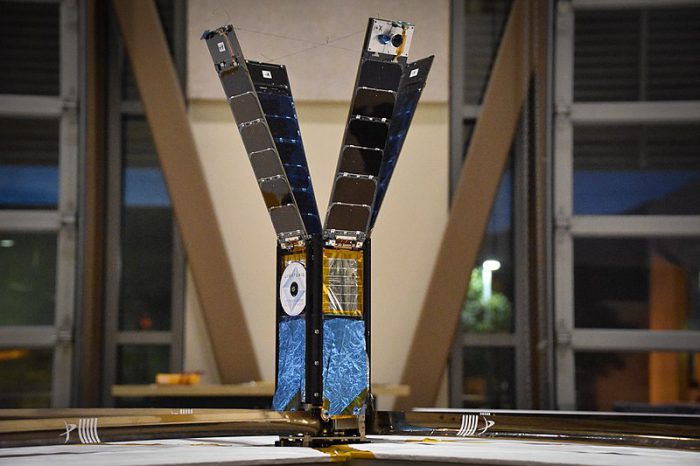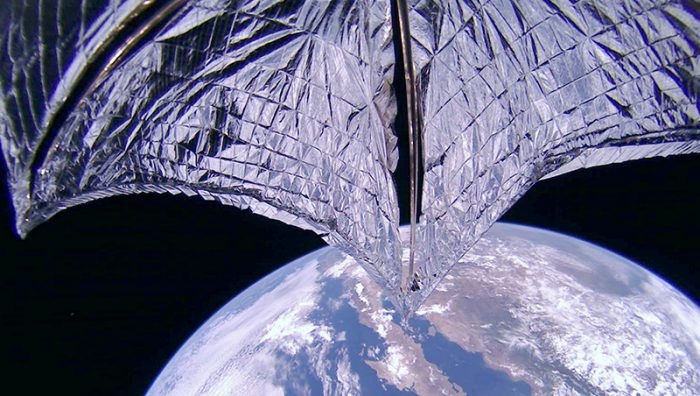Last Tuesday, July 23, a revolutionary spacecraft spread its wings and took flight. It is called Lightsail 2 and it is different than pretty much any craft flying through space. Take a look...
A perfect day for sailing! Images from the spacecraft confirm the solar sails deployed on 23 June 2019 at 11:47 PDT. Details at https://t.co/FZahKXhJh5 pic.twitter.com/ySyR4zUNJv
— Planetary Society (@exploreplanets) July 24, 2019
That angle, taken by a small camera on board the craft, showed the sail being 'deployed', or spread open. If you could see it happening from the outside, it would look something like this computer interpretation.
SAIL DEPLOYMENT COMPLETE! We're sailing on SUNLIGHT!!!!! pic.twitter.com/PA74NMa7Ry
— Planetary Society (@exploreplanets) July 23, 2019
A craft that looks like that can seem like science fiction. But Lightsail 2 is very real and is flying around Earth as we speak. There are two ways to look at its story — in the present and in the future — and both of them are impressive. Let's do that right now.
Give us proof
Humans have used wind for sea travel for centuries. (Getty Embed)
Lightsail 2's current mission is what is known in the science biz as proof-of-concept. What this means simply is that it is being done to show that an idea (a.k.a. the concept) can actually work in the real world. And that idea is that solar sails can power spacecraft.
We're all generally familiar with the idea of a sail on a boat (or if not, at least a flag flapping in the breeze). A sail is powered by wind — particles of air in motion. As wind hits the wide, thin-but-strong surface of the sail, it pushes forward whatever is attached to that sail, usually a boat. Voilà, motion!
Photons go!

A Cubesat, the type of satellite carried by Lightsail 2. (Wikimedia Commons/Planetary Society)
Of course, outer space has no atmosphere, and therefore no wind. So what exactly is pushing Lightsail 2? As the name suggests, the answer is light. Kind of...
The sun — and all stars — push out incredible amount of light energy particles called photons. Photons have no mass, but they do travel at incredible speeds (light speed, to be exact!). Lightsail 2 is designed to use four triangular Mylar sails to capture this energy and send it through space. It sails on light!
Distant futures

Alpha Centauri is a target that scientist hope we could one day reach with solar sail technology. (NASA)
The owners of Lightsail 2 — a collective headed by Bill Nye called the Planetary Society — are hoping to use the craft to one day power toaster-sized satellites called Cubesats. That's the present story of Lightsail 2. But what about that future that we mentioned?
As we've written about before on this site, solar sailing looks like the best way we have of sending probes to other worlds! Currently, the nearest solar system to our own is Alpha Centauri, which is 4.37 light years away. One of the fastest spacecraft that we have flown so far — the Voyager probes — would take 70,000 years to get there. That's around fourteen times longer than all of recorded human history.
But scientists believe that if powered by high powered lasers — light photons — solar sail craft could send a tiny probe there at around 20% the speed of light. That would mean that it could make the same journey in just 20 years.
Lightsail 2 is not the exact craft that is going to take us to alien solar systems. But any advance in this technology takes us one step closer to realizing the best hope that we've got of getting there.
Sail on, star sailor !
 Open wide! The sail have opened on Lightsail 2! (Planetary Society)
Open wide! The sail have opened on Lightsail 2! (Planetary Society)










Amazing!